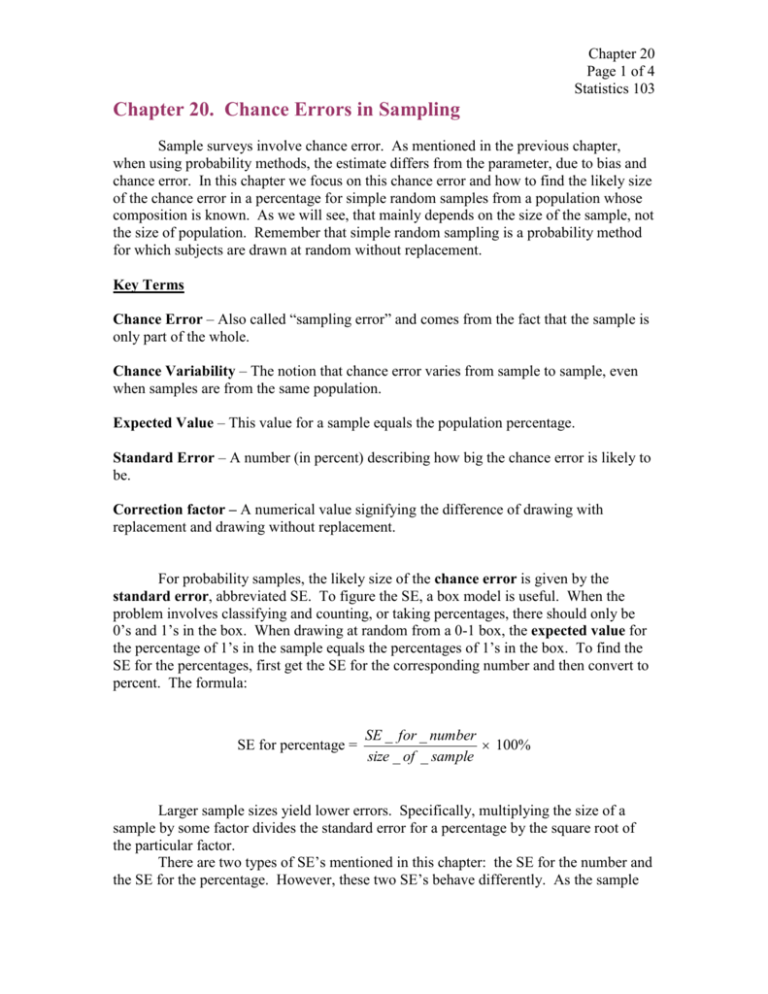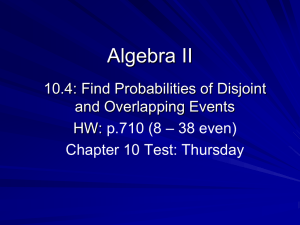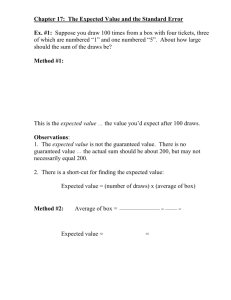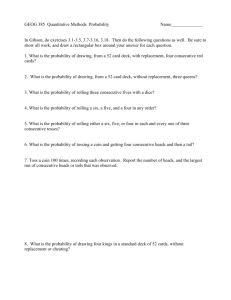Ch 20
advertisement

Chapter 20 Page 1 of 4 Statistics 103 Chapter 20. Chance Errors in Sampling Sample surveys involve chance error. As mentioned in the previous chapter, when using probability methods, the estimate differs from the parameter, due to bias and chance error. In this chapter we focus on this chance error and how to find the likely size of the chance error in a percentage for simple random samples from a population whose composition is known. As we will see, that mainly depends on the size of the sample, not the size of population. Remember that simple random sampling is a probability method for which subjects are drawn at random without replacement. Key Terms Chance Error – Also called “sampling error” and comes from the fact that the sample is only part of the whole. Chance Variability – The notion that chance error varies from sample to sample, even when samples are from the same population. Expected Value – This value for a sample equals the population percentage. Standard Error – A number (in percent) describing how big the chance error is likely to be. Correction factor – A numerical value signifying the difference of drawing with replacement and drawing without replacement. For probability samples, the likely size of the chance error is given by the standard error, abbreviated SE. To figure the SE, a box model is useful. When the problem involves classifying and counting, or taking percentages, there should only be 0’s and 1’s in the box. When drawing at random from a 0-1 box, the expected value for the percentage of 1’s in the sample equals the percentages of 1’s in the box. To find the SE for the percentages, first get the SE for the corresponding number and then convert to percent. The formula: SE for percentage = SE _ for _ number 100% size _ of _ sample Larger sample sizes yield lower errors. Specifically, multiplying the size of a sample by some factor divides the standard error for a percentage by the square root of the particular factor. There are two types of SE’s mentioned in this chapter: the SE for the number and the SE for the percentage. However, these two SE’s behave differently. As the sample Chapter 20 Page 2 of 4 Statistics 103 size increases, the SE for the number also increases but the SE for the percentage decreases: The SE for the sample number goes up like the square root of the sample size. The SE for the sample percentage goes up like the square root of the sample size. When estimating percentages, accuracy depends mainly on the absolute size of the sample, rather than size relative to population. This is true if the sample is only a small part of the population, which is the usual case. For example, suppose a drop of liquid from a bottle is submitted to a laboratory for testing. The size of the sample would not matter if the bottle were mixed well because a drop should be a good representation of the whole bottle. Remember that there are two ways to draw from a box: Drawing with replacement Drawing without replacement When the draws are made without replacement, the formula gives a good approximation, provided that the number of draws is small in comparison to the number of tickets in the box. The square root law is exact when the draws are made with replacement. On the other hand, when drawing without replacement, to get the exact SE you have to multiply by the correction factor: number _ of _ tickets _ in _ boxnumber _ of _ draws number _ of _ tickets _ in _ boxone When the number of tickets in the box is much larger that the number of draws, the correction factor is nearly one. Example, pg. 371, #3 Solution (a) There should be 50,000 tickets because there are 50,000 forms. (b) Each ticket in the box should be 0 or 1. Zero refers to gross income under $50,000 and 1 refers to the gross income over $50,000. (c) False because the standard deviation is 1 4 2 SD (1 0) 5 5 5 (d) True because the sample is 900. (e) The expected value is 180. Also, 19% of 900 = 171 and 21 % of 900 = 189. 2 The SE for the sum is 900 12 . The number of sample forms with gross 5 income over $50,000 is 180 give or take 12. Relating the interval from 19% to 21% to the normal curve: Chapter 20 Page 3 of 4 Statistics 103 Lower value = 171 180 0.75 12 Upper value = 189 180 0.75 12 Referring to the z-table, the area between z = –0.75 and z = 0.75 is approximately 55%. Draw graph (a) More information is needed to do this problem. You need to know the percentage of forms with gross incomes over $75,000. The average gross income is $37,000. The normal curve cannot be used to find 9%-11% of gross incomes over $75,00 because this is very far from being normal. Example, pg. 371, #5 Solution The total weight of the group is like the sum of 50 draws from the box; the average of the box is 150 pounds and the SD is 35 pounds. (Remember that one ton is 2,000 pounds). The expected value for the sum is 7,500 pounds and the SE is 50 35 250 pounds. z 8000 7500 2 250 Find the area underneath the curve for values greater than 8,000 pounds which corresponds to z > 2. Using the z-table, the area between z = -2 and z = 2 is 95.45%. Now find the area under the curve for z > 2: 100%-95.45% = 4.55% 4.55% 2% 2 The chance is about 2%. A better elevator is recommended. Draw graph Chapter 20 Page 4 of 4 Statistics 103 Example, pg. 371, #6 Solution Option (ii) is right because in absolute terms, the California sample is bigger than the Nevada sample and therefore more accurate for estimating percents. The size of the sample relative to the size of the state is basically irrelevant. Homework: 1, 2, 4, 7, 8, 9, 10, 11 Consider the following example. A health study is based on a representative cross section of 6,672 Americans ages 18-79. A sociologist wishes to interview these people but can only sample 100 of them. With a simple random sample, the expected value for the sample percentage equals the population percentage. However, the sample percentage will not be equal to its expected value. It will be off by some chance error. This chance error is the standard error.







